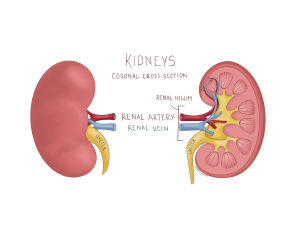62 The Renal System Overview
What is the Renal System?
If we think of the cardiovascular system as a system of pipes, the renal system works functions like a pressure regulator and water filter, maintaining stable blood pressure and removing excess solutes from the blood.
The focal point of the renal system are the kidneys, two bean-shaped organs located on the posterior side of the abdominal wall. Blood reaches the left and right kidneys via the corresponding renal arteries, which branch directly from the aorta. Once blood has been filtered, it returns to systemic circulation via the left and right renal veins. Blood vessels enter and exit the kidneys through the renal hilum, the inner, concave portion of the kidney. The ureters, which transport urine from the kidneys to the bladder, also pass through the renal hilum.

Figure 120 Anterior view of the kidneys and the renal hilum (encompassing the renal artery, vein and ureters)
Blood primarily carriers water and several solutes like sodium, chlorine, proteins, blood-soluble fats, red blood cells, and pathogens. The kidneys play a key role in controlling the body’s blood pressure through filtering, reabsorbing water, and maintaining stable concentrations of various solutes, like sodium or potassium. Imagine eating a big serving of french fries. The sodium concentration in your blood will probably spike. This rise in sodium levels will signal your kidneys to filter blood entering the renal arteries in order to excrete more sodium in the urine, thereby restoring balance and maintaining the body’s (internal stability) homeostasis.
As the individual sodium ions make their way through the kidney, they eventually enter the tube-like ureters, which extend inferiorly from the kidneys. The sodium, now dissolved in urine, travels to the bladder in the lower part of your abdomen for excretion when you visit the washroom.

